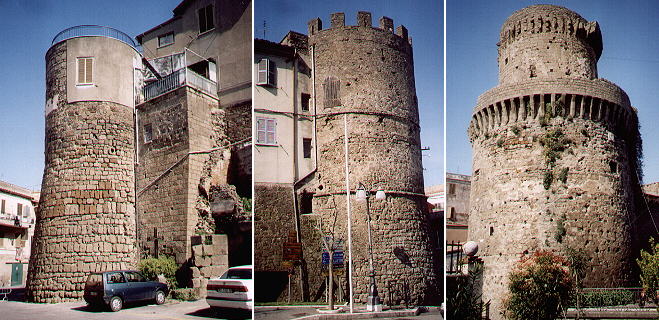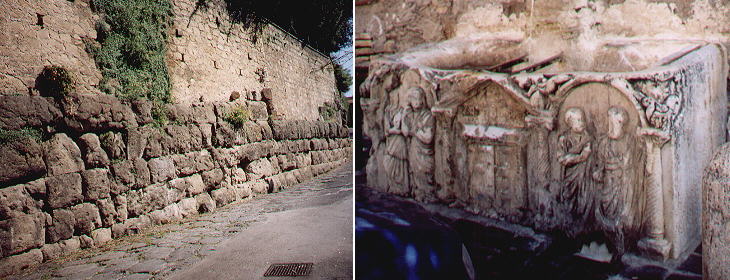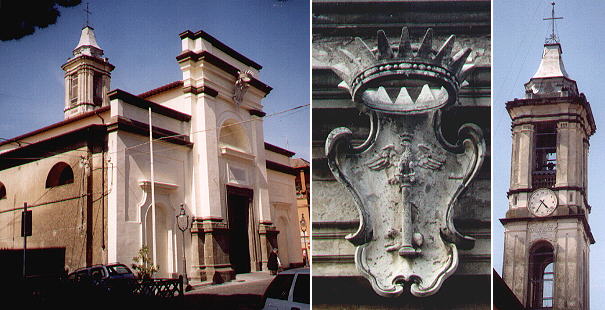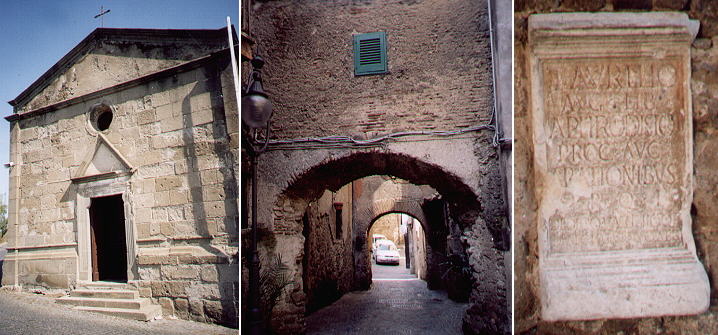

Civita Lavinia, today Lanuvio, is another town the Romans associated with the wanderings of the Trojan
prince Aeneas in southern Latium. According to the myth the town of Lavinia was founded by Aeneas in honour of his wife Lavinia,
daughter of Latinus, king of Latium, and son of Ulysses and the goddess Circe. This narration does not pay too
much attention to consistency. Aeneas and Ulysses, both wandered several years after they left Troy (at the same time) and it seems unlikely that
Aeneas could marry a grand daughter of Ulysses, but this union had the advantage of providing the Romans with both Trojan and Greek ancestors (see also Albano and S. Felice Circeo).
For sure Lavinia was a site populated since very ancient times. Its location on a hill accessible only from one side and its commanding view
over the plain and the sea, gave it those security requisites which were of paramount importance in the development of ancient towns.
Towers of Lanuvio
The military aspect of Lavinia is still evident in the walls and towers which protect its historical part. The tower shown on the left was built on a previous Roman wall, while the other two towers show medieval and Renaissance features.
Roman walls and ancient sarcophagus
Lavinia was renowned for its temples. The Romans built walls on the slopes of the hill to obtain the large terraces they needed for
the erection of temples and of their ancillary facilities. While the temples are lost, their location is indicated by the walls which supported the terraces.
The old town retains some elements of its Roman period (in the image above a Roman sarcophagus turned into a fountain; in the image used as a background for this page you can see
a Roman relief showing a triton and a mermaid; in the last image of the page, a Roman inscription).
Main church
Lavinia was for many centuries a fief of the Colonna family.
The main church was built at various stages at their expense: the fine Baroque bell tower was added in 1680.
S. Maria delle Grazie and other details of Lanuvio
The old town inside the walls and its immediate surroundings near the rural sanctuary of S. Maria delle Grazie have
retained a very evocative and peaceful atmosphere.
Excerpts from Giuseppe Vasi 1761 Itinerary related to this page:
Civita Lavinia, oggi castello
Tre miglia lungi da Gensano a destra della via Appia, conserva questa, a dispetto del tempo divoratore, il nome dell'antichissima cittą, ma non
gią l'antico sito di quella, di cui tante cose memorabili si leggono, e che Enea fabbricolla, dandole il nome della sua moglie figliuola di Latino.
E sebbene soggiacesse anche essa alle violenze de' Romani per l'ingrandimento di Roma, poi fu patria di Antonino Pio, e di Milone, difeso,
come dicemmo, da M. Tullio. In quell'insigne cittą fu il famoso tempio di Giunone Sospita, e le celebri pitture, una di Atlante, e l'altra di Elena.
|
Next step in your tour of the Environs of Rome: Other Castelli Romani
See my Home Page on Baroque Rome or my
Home Page on Rome in the footsteps of an
XVIIIth century traveller.
|





